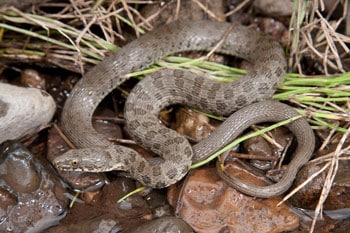USFWS will render a decision on the narrow headed garter snake and the northern Mexican garter snake in fiscal year 2014.
The U.S. Fish and Wildlife Service has proposed that the narrow-headed garter snake (Thamnophis rufipunctatus) and the northern Mexican garter snake (Thamnophis eques) be afforded protections by the Endangered Species Act. The agency, which acted as part of an agreement with the Center for Biological Diversity, also proposed that more than 420,000 acres of habitat for the northern Mexican garter snake and 210,000 acres for the narrow-headed garter snake be set aside as critical habitat for these reptiles. The two southwestern snakes are threatened by non-native species and the loss and degradation of their riparian habitats, the Center said in a statement today.

Photo (c) Pierson Hill
Narrow-headed garter snake.
"These two southwestern snakes have been in trouble for years, so I’m glad they’re finally getting the protection they desperately need to survive,” Collette Adkins Giese, an attorney at the Center said in the statement. "Protecting these snakes and their beleaguered habitat in the Southwest will benefit every other animal that depends on these river systems.”
Want to Learn More?
The decline of these two garter snake species is attributed to the destruction of the streamside habitats in which they live. This destruction, the Center says is due to livestock grazing, the removal of water from the streams, and agricultural and urban sprawl. The introduction of non-native species such as sunfish, bass, and crayfish have also been attributed to the decline of these snakes. According to the Center, the USFWS determined that "83 percent of the northern Mexican garter snake’s populations in the United States and 76 percent of the narrow-headed garter snake’s populations occur at low densities and are likely not viable.”
The Center petitioned the USFWS to protect the Mexican garter snake in 2003 and it was designated a candidate for protection in 2008. The Center in 2011 submitted a status report documenting the need to protect the narrow-headed garter snake. The USFWS will make a decision about whether to protect the snakes in fiscal year 2014.
Narrow-Headed Garter Snake Quick Facts
Diet: small fish, frogs, tadpoles, and salamanders
Size: Up to 3.5 feet.
Color: grayish colored body with irregular dark spots and no stripes.
Threats: Predation of non-native species such as bullfrogs and crayfish, habitat degradation due to overgrazing, water diversion, drought and overuse of lands.
Status: Candidate for federal protection under the Endangered Species Act.
Northern Mexican Garter Snake Quick Facts
Diet: tadpoles, minnows, small fish.
Size: Up to 3 feet.
Color: Olive, olive-brown or olive-gray. Three stripes run the length of the body with a yellow stripe down the back. A portion of lateral stripe runs along the fourth scale row, distinguishing T. eques from other gartersnakes.
Threats: Predation of non-native species such as bullfrogs and crayfish, habitat degradation due to overgrazing, water diversion, drought and overuse of lands.
Status: Endangered in the state of New Mexico; candidate for federal protection under the Endangered Species Act.



